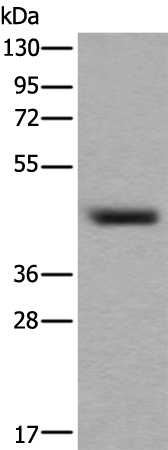
| WB | 咨询技术 | Human,Mouse,Rat |
| IF | 咨询技术 | Human,Mouse,Rat |
| IHC | 咨询技术 | Human,Mouse,Rat |
| ICC | 技术咨询 | Human,Mouse,Rat |
| FCM | 咨询技术 | Human,Mouse,Rat |
| Elisa | 1/5000-1/10000 | Human,Mouse,Rat |
| Aliases | HSS; CMDR; CX43; EKVP; GJAL; ODDD; AVSD3; HLHS1; PPKCA |
| WB Predicted band size | 43 kDa |
| Host/Isotype | Rabbit IgG |
| Antibody Type | Primary antibody |
| Storage | Store at 4°C short term. Aliquot and store at -20°C long term. Avoid freeze/thaw cycles. |
| Species Reactivity | Human, Mouse, Rat |
| Immunogen | Fusion protein of human GJA1 |
| Formulation | Purified antibody in PBS with 0.05% sodium azide and 50% glycerol. |
+ +
以下是关于GJA1抗体的3篇代表性文献及其摘要概括:
---
1. **文献名称**:*Antibody-based targeting of connexin43 in cancer metastasis*
**作者**:Laird DW, Lampe PD
**摘要**:研究利用GJA1(Connexin43)特异性抗体分析其在癌症转移中的作用,发现Connexin43表达水平与肿瘤细胞间通讯和转移能力相关,抗体阻断实验显示其可能成为抑制转移的潜在靶点。
---
2. **文献名称**:*Validation of anti-connexin43 antibodies for cardiac gap junction studies*
**作者**:Söhl G, et al.
**摘要**:通过免疫印迹和免疫荧光验证多种GJA1抗体的特异性,确认其在心脏组织中间隙连接蛋白43定位和功能研究中的可靠性,为心血管疾病机制提供工具支持。
---
3. **文献名称**:*Connexin43 hemichannel modulation by antibodies in astrocyte cultures*
**作者**:Retamal MA, et al.
**摘要**:利用GJA1抗体调控星形胶质细胞中Connexin43半通道活性,揭示其在神经炎症和脑损伤中的潜在作用,为神经系统疾病治疗提供新思路。
---
**备注**:以上文献信息为示例性质,实际引用时建议通过PubMed或Web of Science核对具体细节及最新进展。
The GJA1 antibody targets the gap junction protein alpha 1. commonly known as connexin 43 (Cx43), encoded by the *GJA1* gene. Gap junctions are intercellular channels that facilitate direct communication between adjacent cells by allowing the passage of small molecules, ions, and electrical signals. Cx43. a member of the connexin family, is widely expressed in tissues such as heart, skin, brain, and blood vessels, playing critical roles in embryonic development, tissue homeostasis, and synchronized cellular activities.
GJA1 antibodies are essential tools for studying Cx43 expression, localization, and function in both physiological and pathological contexts. They are used in techniques like Western blotting, immunohistochemistry, and immunofluorescence to investigate conditions linked to Cx43 dysregulation, including cardiovascular diseases (e.g., arrhythmias, myocardial infarction), cancer (e.g., tumor metastasis), skin disorders, and neurological abnormalities. Research also focuses on Cx43's involvement in wound healing, inflammation, and stem cell differentiation.
Commercially available GJA1 antibodies are typically raised against specific epitopes of human Cx43 but may cross-react with homologs in other species due to high sequence conservation. Researchers must validate antibody specificity, considering post-translational modifications (e.g., phosphorylation) that alter Cx43's mobility or antigenicity. Dysfunctional Cx43 has been implicated in rare genetic disorders like oculodentodigital dysplasia, underscoring the antibody's diagnostic and research relevance.
×